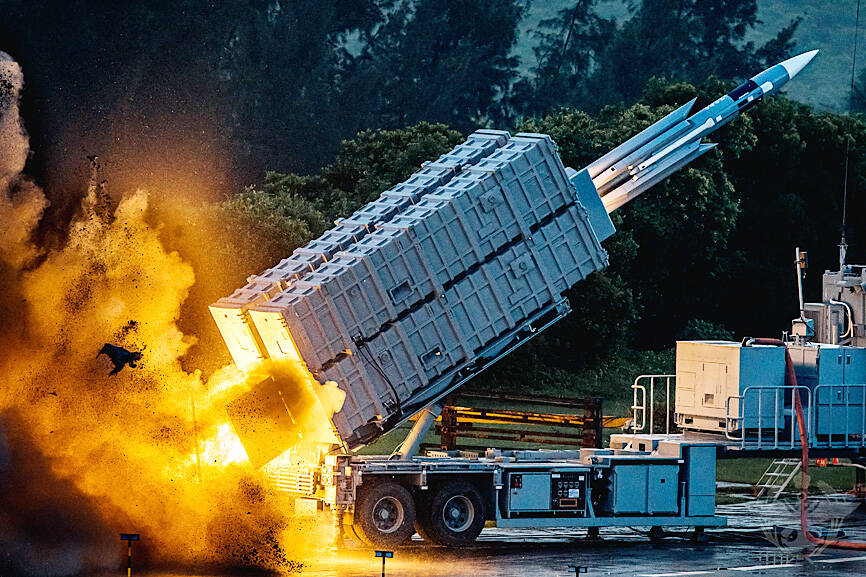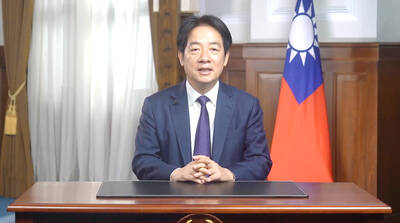More than 1,000 domestically produced missiles are expected to be delivered next year and a production plan would be adjusted according to the nation’s needs, defense sources said on Saturday.
The Chungshan Institute of Science and Technology (CSIST) is manufacturing the missiles as part of its Sea-Air Combat Power Improvement Plan.
The plan has been allocated a special budget of NT$228.9 billion (US$7.4 billion) from last year to 2026, with this year’s budget being the highest at NT$60.9 billion, one of the sources said.

Photo: EPA-EFE / the Ministry of National Defense
Last year’s budget was NT$46.3 billion, while the budget would be NT$47.4 billion next year, NT$45.8 billion in 2025 and NT$28.3 in 2026, the source said.
The allocation is expected to result in the largest delivery of missiles next year to address developments in the Taiwan Strait, they said.
This year’s missile production is estimated to be close to 1,000, the source said.
The overall spending plan includes two phases of mobile coastal-defense cruise missiles, an air-defense system, an uncrewed aerial vehicle (UAV) system, the Wan Chien air-to-ground missile system, the Hsiung Feng II-E (HF-2E) land attack cruise missile system, and two phases of high-performance naval vessels, as well as weapons systems for coast guard vessels, the source said.
The manufacture of the Wan Chien air-to-ground missile system is to be completed next year, while the UAV and the HF-2E missile systems would be ready in 2025, the source said.
Asked whether the government would unveil a second purchase package or raise the annual defense budget to boost weapons manufacturing, a high-ranking official said on condition of anonymity that the government would follow the most suitable plan based on its predictions of how the cross-strait situation would develop.
With the delivery of sea and air missiles, the military would gradually adjust its air-defense, anti-ship and naval units, while retiring old missile systems, the official said.
Countries such as the US, Japan and China are paying attention to the combat power of Taiwan’s missile forces, they said, adding that the military would unveil the outcomes of its improvement plan soon.
In other developments, a source close to the military yesterday said that the army is customizing reconnaissance drones made by the CSIST to give them combat capabilities.
Some of the UAVs have been equipped with a laser targeting system that can lock on to targets and transmit the coordinates to a military base, the source said.
Others would be equipped with weapons systems to give them the capability to retaliate against possible to attacks while on reconnaissance missions, the source said.
The drones being refitted are among the 50 rotor-based models ordered from the CSIST for NT$779.98 million. Fourteen were delivered last year and 36 this year.
The UAV was unveiled at a military demonstration in January. The army at the time said soldiers need only two weeks of training to operate the drones, with refresher courses scheduled every two years.
The drone is 180cm long, 39cm wide and 55.7cm high. It has a top speed of 64kph and can climb to 1,500m.
Weighing 25kg, it can withstand level 6 winds on the Beaufort Wind Scale and can fly for 60 minutes on a single charge.

ACTION PLAN: Taiwan would expand procurement from the US and encourage more companies to invest in the US to deepen bilateral cooperation, Lai said The government would not impose reciprocal tariffs in retaliation against US levies, President William Lai (賴清德) said yesterday, as he announced five strategies to address the issue, including pledging to increase Taiwanese companies’ investments in the US. Lai has in the past few days met with administrative and national security officials, as well as representatives from various industries, to explore countermeasures after US President Donald Trump on Wednesday last week announced a 32 percent duty on Taiwanese imports. In a video released yesterday evening, Lai said that Taiwan would not retaliate against the US with higher tariffs and Taiwanese companies’ commitments to

‘SPECIAL CHANNEL’: Taipei’s most important tasks are to stabilize industries affected by Trump’s trade tariffs and keep negotiations with Washington open, a source said National Security Council Secretary-General Joseph Wu (吳釗燮) arrived in the US for talks with US President Donald Trump’s administration, a source familiar with the matter said on Friday. Wu was leading a delegation for a meeting known as the “special channel,” the Financial Times reported earlier. It marked Trump’s first use of the channel since returning to the White House on Jan. 20. Citing a source familiar with the matter, the Financial Times reported that Minister of Foreign Affairs Lin Chia-lung (林佳龍) was also a part of the delegation. The visit came days after China concluded war games around Taiwan and amid Trump’s

Intelligence agents have recorded 510,000 instances of “controversial information” being spread online by the Chinese Communist Party (CCP) so far this year, the National Security Bureau (NSB) said in a report yesterday, as it warned of artificial intelligence (AI) being employed to generate destabilizing misinformation. The bureau submitted a written report to the Legislative Yuan in preparation for National Security Bureau Director-General Tsai Ming-yen’s (蔡明彥) appearance before the Foreign Affairs and National Defense Committee today. The CCP has been using cognitive warfare to divide Taiwanese society by commenting on controversial issues such as Taiwan Semiconductor Manufacturing Co’s (TSMC, 台積電) investments in the

HELPING HAND: The steering committee of the National Stabilization Fund is expected to hold a meeting to discuss how and when to utilize the fund to help buffer the sell-off The TAIEX plunged 2,065.87 points, or 9.7 percent, to close at 19,232.35 yesterday, the highest single-day percentage loss on record, as investors braced for US President Donald Trump’s tariffs after an extended holiday weekend. Amid the pessimistic atmosphere, 945 listed companies led by large-cap stocks — including Taiwan Semiconductor Manufacturing Co (TSMC, 台積電), Hon Hai Precision Industry Co (鴻海精密) and Largan Precision Co (大立光) — fell by the daily maximum of 10 percent at the close, Taiwan Stock Exchange data showed. The number of listed companies ending limit-down set a new record, the exchange said. The TAIEX plunged by daily maxiumu in just